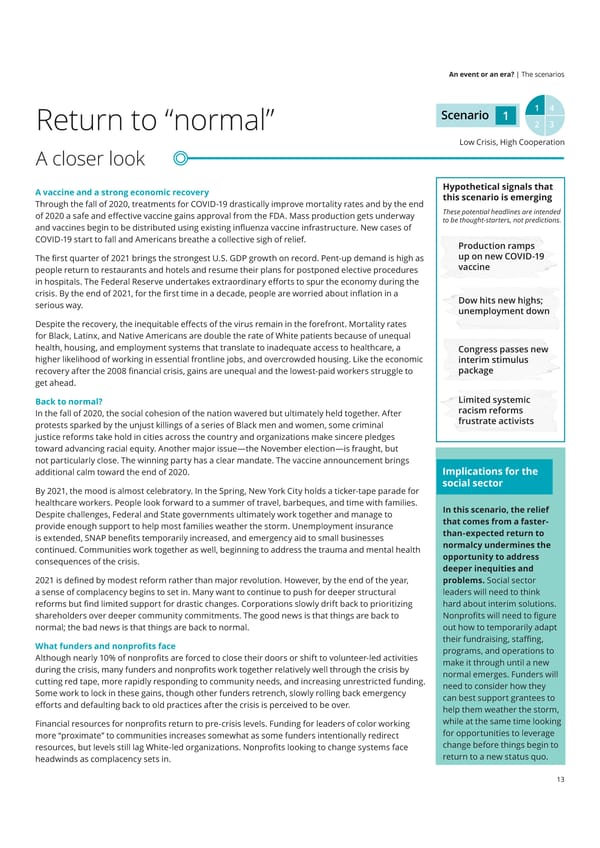An event or an era? | The scenarios Scenario 1 1 4 Return to “normal” 2 3 Low Crisis, High Cooperation A closer look A vaccine and a strong economic recovery Hypothetical signals that Through the fall of 2020, treatments for COVID-19 drastically improve mortality rates and by the end this scenario is emerging of 2020 a safe and effective vaccine gains approval from the FDA. Mass production gets underway These potential headlines are intended and vaccines begin to be distributed using existing influenza vaccine infrastructure. New cases of to be thought-starters, not predictions. COVID-19 start to fall and Americans breathe a collective sigh of relief. Production ramps The first quarter of 2021 brings the strongest U.S. GDP growth on record. Pent-up demand is high as up on new COVID-19 people return to restaurants and hotels and resume their plans for postponed elective procedures vaccine in hospitals. The Federal Reserve undertakes extraordinary efforts to spur the economy during the crisis. By the end of 2021, for the first time in a decade, people are worried about inflation in a Dow hits new highs; serious way. unemployment down Despite the recovery, the inequitable effects of the virus remain in the forefront. Mortality rates for Black, Latinx, and Native Americans are double the rate of White patients because of unequal health, housing, and employment systems that translate to inadequate access to healthcare, a Congress passes new higher likelihood of working in essential frontline jobs, and overcrowded housing. Like the economic interim stimulus recovery after the 2008 financial crisis, gains are unequal and the lowest-paid workers struggle to package get ahead. Back to normal? Limited systemic In the fall of 2020, the social cohesion of the nation wavered but ultimately held together. After racism reforms protests sparked by the unjust killings of a series of Black men and women, some criminal frustrate activists justice reforms take hold in cities across the country and organizations make sincere pledges toward advancing racial equity. Another major issue—the November election—is fraught, but not particularly close. The winning party has a clear mandate. The vaccine announcement brings additional calm toward the end of 2020. Implications for the By 2021, the mood is almost celebratory. In the Spring, New York City holds a ticker-tape parade for social sector healthcare workers. People look forward to a summer of travel, barbeques, and time with families. In this scenario, the relief Despite challenges, Federal and State governments ultimately work together and manage to that comes from a faster- provide enough support to help most families weather the storm. Unemployment insurance than-expected return to is extended, SNAP benefits temporarily increased, and emergency aid to small businesses normalcy undermines the continued. Communities work together as well, beginning to address the trauma and mental health opportunity to address consequences of the crisis. deeper inequities and 2021 is defined by modest reform rather than major revolution. However, by the end of the year, problems. Social sector a sense of complacency begins to set in. Many want to continue to push for deeper structural leaders will need to think reforms but find limited support for drastic changes. Corporations slowly drift back to prioritizing hard about interim solutions. shareholders over deeper community commitments. The good news is that things are back to Nonprofits will need to figure normal; the bad news is that things are back to normal. out how to temporarily adapt What funders and nonprofits face their fundraising, staffing, Although nearly 10% of nonprofits are forced to close their doors or shift to volunteer-led activities programs, and operations to during the crisis, many funders and nonprofits work together relatively well through the crisis by make it through until a new cutting red tape, more rapidly responding to community needs, and increasing unrestricted funding. normal emerges. Funders will Some work to lock in these gains, though other funders retrench, slowly rolling back emergency need to consider how they efforts and defaulting back to old practices after the crisis is perceived to be over. can best support grantees to help them weather the storm, Financial resources for nonprofits return to pre-crisis levels. Funding for leaders of color working while at the same time looking more “proximate” to communities increases somewhat as some funders intentionally redirect for opportunities to leverage resources, but levels still lag White-led organizations. Nonprofits looking to change systems face change before things begin to headwinds as complacency sets in. return to a new status quo. 13
 US Deloitte Monitor Institute Page 12 Page 14
US Deloitte Monitor Institute Page 12 Page 14